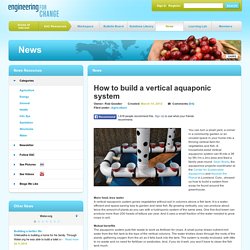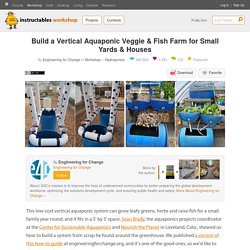

Local, Sustainable, Organic Food. How to build a vertical aquaponic system. You can turn a small yard, a corner in a community garden or an unused space in your home into a thriving vertical farm for vegetables and fish.

A household-sized vertical aquaponic system can fit into a 3ft by 5ft (1m x 2m) area and feed a family year-round. Sean Brady, the aquaponics projects coordinator at the Center for Sustainable Aquaponics and Nourish the Planet in Loveland, Colo., showed us how to build a system from scrap he found around the greenhouse. More food, less water A vertical aquaponic system grows vegetables without soil in columns above a fish tank. It is a water-efficient and space-saving way to garden and raise fish. By growing vertically, you can produce about twice the amount of plants as you can with a hydroponic system of the same area. Mutual benefits The aquaponic system puts fish waste to work as fertilizer for crops. You would have to replace lost water as needed, power the pump and feed the fish. Build time: About two hours. Seed the plants in these. Build a vertical aquaponic veggie & fish farm for small yards & houses.
This low-cost vertical aquaponic system can grow leafy greens, herbs and raise fish for a small family year round, and it fits in a 5' by 3' space.

Sean Brady, the aquaponics projects coordinator at the Center for Sustainable Aquaponics and Nourish the Planet in Loveland, Colo., showed us how to build a system from scrap he found around the greenhouse. We published a version of this how-to guide at engineeringforchange.org, and it's one of the good ones, so we'd like to share it with Instructables, too. What it is A vertical aquaponic system grows vegetables without soil in columns above a fish tank.
By growing vertically, you can produce about twice the amount of plants as you can with a hydroponic system of the same area. One five-foot tower can produce more than 200 heads of lettuce per year. The system puts fish waste to work as fertilizer for crops. You do have to replace lost water as needed, power the pump and feed the fish. Build time About two hours. Getting ready for the end of growth on Earth. Long Beach, California—Paul Gilding wants to scare us.

He wants to scare us into acting before it's too late. "The Earth is Full. Full of us, full of our stuff. Full of our waste," he said during his TED talk. In financial terms, we live on the Earth like we are spending 50 percent more than we earn.